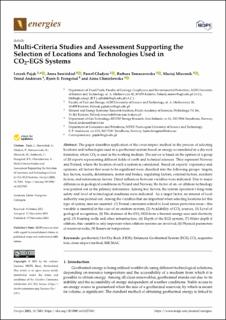| dc.description.abstract | The paper describes application of the cross-impact method in the process of selecting locations and technologies used in a geothermal system based on energy accumulated in a dry rock formation, where CO2 is used as the working medium. The survey is based on the opinion of a group of 20 experts representing different fields of earth and technical sciences. They represent Norway and Poland, where the location of such a system is considered. Based on experts’ experience and opinions, all factors that seem to be significant were classified into the following groups: targets, key factors, results, determiners, motor and brakes, regulating factors, external factors, auxiliary factors, and autonomous factors. Direct influences between variables were indicated. Due to major differences in geological conditions in Poland and Norway, the factor of on-or offshore technology was pointed out as the primary determiner. Among key factors, the system operation’s long-term safety and level of technological readiness were indicated. As a target factor, an interest of local authority was pointed out. Among the variables that are important when selecting locations for this type of system, nine are essential: (1) Formal constraints related to local nature protection areas—this variable is essential in the case of an onshore system; (2) Availability of CO2 sources; (3) Level of geological recognition; (4) The distance of the CO2-EGS from a thermal energy user and electricity grid; (5) Existing wells and other infrastructure; (6) Depth of the EGS system; (7) Water depth if offshore, this variable is only important when offshore systems are involved; (8) Physical parameters of reservoir rocks; (9) Reservoir temperature. © 2021 by the authors Licensee MDPI, Basel, Switzerland. | en_US |

